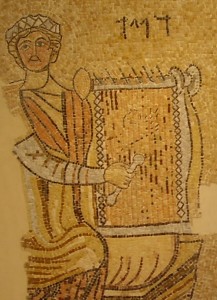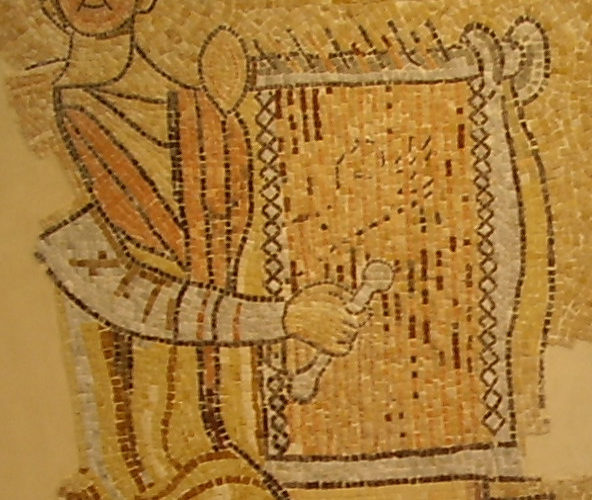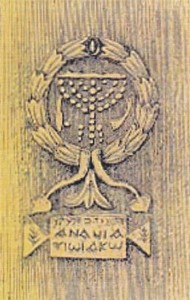Jewish Gaza

Biblically, the area was allotted to the tribe of Judah, but the Jews never quite secured it. It’s always been an area of conflict, an arena for confrontation between Jews and hostile neighbours.
After the Biblical Exodus, during the period of the Judges, the territory fell under Philistine control. The Philistines were an Aegean people, meaning they came from the area of modern Greece. In ancient Egyptian writings, they are described as one of the “Sea Peoples” that attempted to invade Egypt and conquer the whole area.
Even if you think you’ve never heard of the Philistines, you have. The most infamous Philistines are the warrior Goliath, who was famously defeated by King David as a youth and Delilah, the biblical hottie that seduced the Israelite strongman Samson and brought about his downfall.
The Philistines exited from history in 722 BCE, when they were taken into captivity by the Assyrians.
After the Philistines disappeared, the area came under the control of various empires, e.g. the Egyptians, the Greeks and the Romans. The only common denominator was the Jews. For example, in 145 BCE Gaza came under Maccabean control (you remember the Maccabees, their victories are still celebrated during Hanukkah). This is what the Book of Maccabees (1:15) has to say about Gaza:
“Not a strange land have we conquered, and not over the possessions of strangers have we ruled, but of the inheritance of our Fathers that was in the hands of the enemy and conquered by them unlawfully. And as for us, when we had the chance, we returned to ourselves the inheritance of our Fathers.”
It might seem strange today to call Gaza the “inheritance of our [Jewish] fathers”, but there it is.
After the great Jewish revolts against the Roman empire in 67 CE and again in 132 CE, with the destruction of Jewish sovereignty in the land of Israel, Gaza again played a strange role in Jewish history: it served as the main marketplace for Jewish slaves into the Roman empire. Nonetheless, the Jews returned, and by the 4th century, the Jewish community flourished. Gaza was the main port for Jewish commerce in the Holy Land. More than this, over the next few centuries, Gaza served as a center of Talmudic and Kabbalistic (Jewish mysticism) studies. But even here, things went off track. In 1665 the Kabbalist Nathan of Gaza became a key “prophet” of the false messiah, Shabbatai Tzvi. Tzvi created a messianic stir in the Jewish world until he was forcibly converted to Islam. This sent shockwaves throughout the Jewish diaspora, which took decades to recover from “the messiah’s” apostasy.
By the time the Arabs arrived in the 7th century CE/AD, Jews had been in Gaza for over 2000 years. In 1929, when the area was under British control, after the Jews of Hebron were massacred by the local Arab population, British forces evacuated the entire Jewish community of Gaza for fear of a massive pogrom.
Archaeologically speaking, several important finds have been uncovered. First, a 6th century synagogue. More dramatically, in 1965 Egyptian archaeologists discovered a mosaic image of King David playing a harp. This mosaic had once graced this 6th century synagogue. What happened to the archaeology? When it came to King David, locals promptly gouged out his face for fear that it demonstrates a connection between Jews and Gaza. When the Israel Defense Forces conquered the area during the 1967 war, Israeli archaeologists removed what was left of the mosaic and, using a photograph, restored the face. It is now on permanent display at the Israel Museum.
The Great Mosque of Gaza was originally a Crusader church. But one of the upper columns in this magnificent structure originated in an ancient synagogue: Near the top of the column a menorah was engraved. The menorah was encircled by a wreath. On the right of it was a shofar, the ram’s horn sounded on Rosh Hashanah, and on its left was a lulav, a palm branch used during the fall festival of Sukkot (Tabernacles). The inscription below, in Hebrew and Greek, reads “Hananiah, Son of Jacob”. He probably sculpted this engraving, or it was dedicated to him.
The menorah remained there for all to see from the time of the Crusaders. Recently, it was destroyed by locals.
So it seems that Gaza has always been problematic for Israel. But the Bible does state that there was one period when Judah and Israel had peace. This is the way it describes it: “So Judah and Israel lived in safety, every man under his vine and his fig tree, from Dan even to Beersheba.” Meaning, there were no ancient missiles and no war. This period of bliss was during the reign of King Solomon. According to the book of Kings (1 Kings 4:24-5), the key to the peace was the fact that Solomon “had dominion over everything west of the River, from Tiphsah all the way to Gaza.”
For more information:
http://www.americanthinker.com/2009/02/gazas_rich_jewish_history.html
http://members.bib-arch.org/publication.asp?PubID=BSBA&Volume=20&Issue=2&ArticleID=4
Check out my latest blog on the Times of Israel: Those TV cameras responsible for civilian deaths in Gaza


